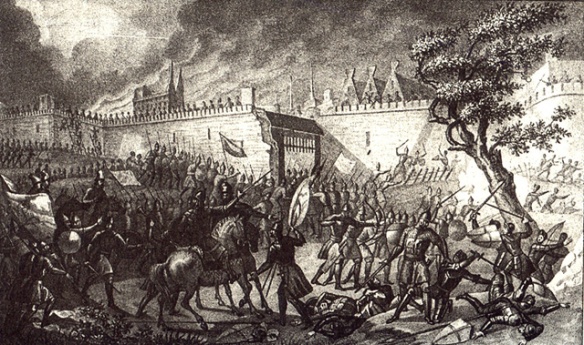Siege of Narva by the Russians in 1558 by Boris Chorikov, 1836.
Map of campaigns in Livonia, 1558–1560.
Also known as the ‘‘Livonian War.’’ In 1558, Ivan IV invaded Estonia. His army massacred 10,000 at the sack of Dorpat (1558), went on to sack 20 more towns, and captured Narva. The Livonian Order brought in Landsknechte with guns, but were unable to staunch the assault. The Order fought its last battle at Ermes (August 2, 1560), then disbanded. This collapse of the Brethren in face of Ivan’s strel’sty and servitor cavalry opened Livonia to partition as Poland-Lithuania, Muscovy, Sweden, and Denmark all looked to gain territory. The Muscovite invasion marked the end of the wars of crusade in the Baltic region, but not the end of wars of imperial ambition. These would continue, almost uninterrupted, to 1667.
Despite initial success, Ivan was unable to take other key towns: Reval and Riga held out with Swedish and Polish aid. In 1563, the war spread: Denmark and Sweden fought each other at sea and Ivan attacked into Lithuania. In 1564, the Lithuanians won huge victories over Muscovy at Czasniki and the Ula River, driving Ivan farther into a madness that triggered gross excesses and terror against his own boyars. This Oprichnina[1] lasted to 1571, temporarily taking Muscovy out of the war. The end of the Nordic Seven Years’ War in 1570 threatened Ivan with fresh enemies in the west. He responded by ending the terror at home and invading Livonia in 1572–1573, leaving much fire and destruction in his wake. Then he turned to defend against the Ottomans and Tatars in the deep south of his huge empire. In 1575, a Muscovite army besieged Reval unsuccessfully then ravaged the surrounding lands. The next summer’s campaign was the largest and most destructive of the entire war. In 1577, Ivan personally returned to attack Reval with 30,000 men, then Dünaburg and Kokenhausen. He was nearly killed by a cannonball at Wenden. Enraged, he threatened terrible punishment against the whole town. Whether by accident or with the suicidal intention of escaping the tsar’s wrath, 300 men, women, and children blew themselves up. But Ivan was defeated at Wenden by September 1578 and offered to make peace. He was rebuffed by Stefan Báthory at the head of an army of the new union of Poland-Lithuania (Union of Lublin). Báthory led three expeditions into Russia in 1579, 1580, and 1581–1582, forcing Ivan to surrender his earlier Livonian conquests. This only ensured that fighting over the carcass of Livonia continued in future northern wars in the 17th century.
Suggested Reading: Robert Frost, The Northern Wars, 1558–1721 (2000).
[1] Oprichnina. ‘‘Government apart.’’ Originally this referred to the quixotic decision by Ivan IV (‘‘The Terrible’’) to divide the administration of Muscovy into the ‘‘Oprichnina,’’ a territory free of troublesome nobles which he governed directly, and the rest of Muscovy, or ‘‘Zemshchina’’ (‘‘The Land’’). However, the term is more commonly used about his reign of terror, torture, and arbitrary arrest and executions. The anarchy lasted seven years (1565– 1572), taking Muscovy temporarily out of the First Northern War (1558–1583) while encouraging Poland and Lithuania to form the Union of Lublin in 1569. Ivan’s ‘‘oprichniki’’—quasi-warrior monks who dressed in all black and carried dog’s heads and broomsticks to sniff out and sweep away evil—purged and slaughtered with abandon. In 1570, four thousand were killed in Novgorod alone and the city was gutted. The chaos was so extreme that the ranks of the Cossacks swelled with new recruits and the Crimean Tatars reached and sacked Moscow in May 1571, destroying large parts of the city. They also sacked Tula, Riazan, and several other cities. The combination of depredations by the oprichniki and the Tatar raid left large parts of the Oprichnina desolate and fallow. In 1572, Ivan liquidated the liquidators. That was a model of political terror and control that appealed to an admiring Joseph Stalin nearly 400 years later.
